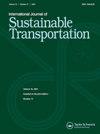Outdoor information panels to convey real-time travel information for transit ridership recovery
IF 3.1
3区 工程技术
Q2 ENVIRONMENTAL STUDIES
International Journal of Sustainable Transportation
Pub Date : 2025-03-04
DOI:10.1080/15568318.2025.2462164
引用次数: 0
Abstract
Transit agencies in the United States have seen a drastic ridership decline since COVID-19. The research team collaborated with Massachusetts Bay Transportation Authority (MBTA) to utilize Outdoor Information Panels (OIPs) along major highways to deliver real-time travel information (RTTI) to encourage increased transit use. An online interview and a household survey were conducted in sequence to gather Great Boston Area (GBA) travelers’ travel experience, preferred RTTI contents, OIP graphic designs, and their stated mode shift in response to OIPs. The top three information items found to encourage transit use are real-time total travel time, next two train arrivals, and real-time parking availability. Additionally, travel cost is more influential for commuter rail (vs. subway) trips and major event (vs. generic) trips. 79% of transit user participants agree that OIPs would improve their travel experience. Trips with more flexible schedules and/or less requirement on carrying passengers and goods, such as social/recreational and major-event trips, are more influenced by RTTI than work, family, and shopping trips. Transit nonusers show a lower tendency to increase their transit use compared to transit users, with their potential increases varying more by trip purpose. A 2.1% emission reduction from work trips is estimated using a regional travel demand model for the GBA. Frequent transit users and nonusers (car users) contribute significantly to emission reductions. Frequent transit users contribute due to their substantial increase in transit use per person, despite being a smaller proportion of the traveling population, while nonusers contribute due to their large proportion, despite a smaller per-person increase in transit use.
户外信息面板,传达实时出行信息,以恢复交通客流量
自2019冠状病毒病以来,美国的公交机构的客流量急剧下降。研究小组与马萨诸塞湾交通管理局(MBTA)合作,利用主要高速公路沿线的户外信息面板(oip)提供实时旅行信息(RTTI),以鼓励增加交通使用。通过在线访谈和家庭调查,我们收集了大波士顿地区(GBA)旅行者的旅行体验、偏好的RTTI内容、OIP平面设计以及他们对OIP的响应模式转变。最能鼓励人们使用交通工具的三项信息是实时总旅行时间、下两列火车到达时间和实时可用停车位。此外,通勤铁路(相对于地铁)旅行和重大活动(相对于一般)旅行的旅行成本影响更大。79%的公共交通用户参与者同意oip将改善他们的出行体验。日程安排更灵活和/或对载客和载货要求较少的旅行,如社交/娱乐和重大活动旅行,比工作、家庭和购物旅行更受RTTI的影响。与公交用户相比,非公交用户增加公交使用的趋势较低,其潜在增长因出行目的而异。根据大湾区的区域旅行需求模型,估计出差可减少2.1%的碳排放。经常使用交通工具的人和不使用交通工具的人(汽车使用者)对减排做出了重大贡献。经常使用交通工具的人虽然在出行人口中所占比例较小,但他们的人均交通工具使用量大幅增加,而不使用交通工具的人的比例很大,尽管人均交通工具使用量的增幅较小。
本文章由计算机程序翻译,如有差异,请以英文原文为准。
求助全文
约1分钟内获得全文
求助全文
来源期刊
CiteScore
8.90
自引率
2.60%
发文量
56
期刊介绍:
The International Journal of Sustainable Transportation provides a discussion forum for the exchange of new and innovative ideas on sustainable transportation research in the context of environmental, economical, social, and engineering aspects, as well as current and future interactions of transportation systems and other urban subsystems. The scope includes the examination of overall sustainability of any transportation system, including its infrastructure, vehicle, operation, and maintenance; the integration of social science disciplines, engineering, and information technology with transportation; the understanding of the comparative aspects of different transportation systems from a global perspective; qualitative and quantitative transportation studies; and case studies, surveys, and expository papers in an international or local context. Equal emphasis is placed on the problems of sustainable transportation that are associated with passenger and freight transportation modes in both industrialized and non-industrialized areas. All submitted manuscripts are subject to initial evaluation by the Editors and, if found suitable for further consideration, to peer review by independent, anonymous expert reviewers. All peer review is single-blind. Submissions are made online via ScholarOne Manuscripts.

 求助内容:
求助内容: 应助结果提醒方式:
应助结果提醒方式:


